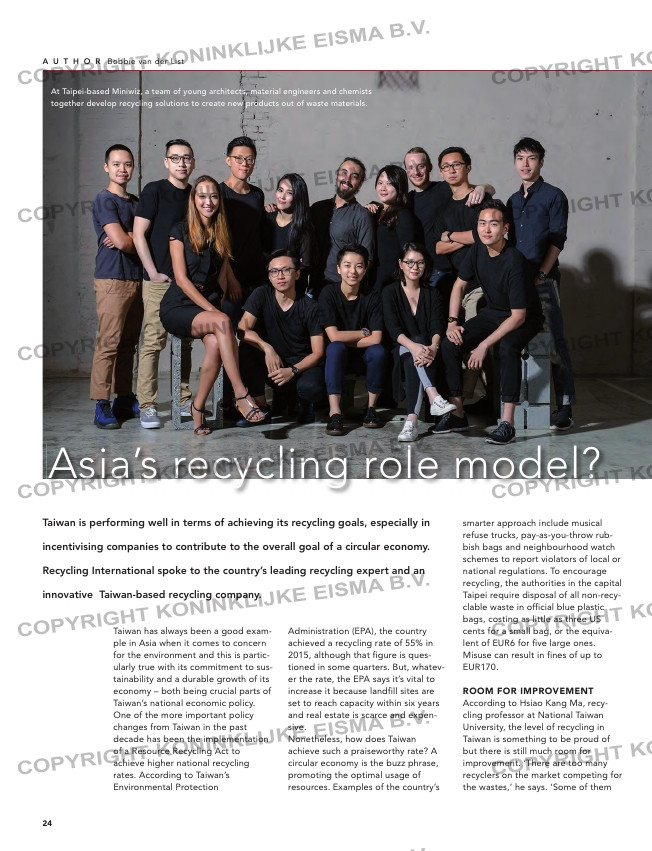Page 24 from: November/December issue

24
Asia’s recycling role model?
Taiwan is performing well in terms of achieving its recycling goals, especially in
incentivising companies to contribute to the overall goal of a circular economy.
Recycling International spoke to the country’s leading recycling expert and an
innovative Taiwan-based recycling company.
still use 15-year-old equipment. We
need innovative technologies to recy-
cle the solar panels and other modern
electronic products.’
This means there are real opportuni-
ties to further develop recycling.
According to Ma, ‘the market needs
to be opened for importing recyclable
waste into Taiwan.’
Whenever talk turns to recycling, any-
where in the world, one of the biggest
challenges is to make sure the produc-
tion of plastic is reduced to an accept-
able level, preventing waste in the
first place. So what is Taiwan doing to
reduce the volume of plastic? ‘There is
what we call a “restricted plastics”
policy ensuring shopping bag reduc-
tion, limiting plastic particles from
cosmetics and personal cleaning prod-
ucts, and so on,’ says Ma.
Ma notes that Taiwan has a good recy-
cling record. ‘By looking at the 2016
data, I can say it does quite well. Of
all general waste, over 60% was recy-
cled whereas 77% industrial of waste
was recycled,’ he adds.
mINIWIZ mAsTERCLAss
To understand the difference, it is cru-
cial to take a closer look at the indus-
try itself. One of the most interesting
Taiwan has always been a good exam-
ple in Asia when it comes to concern
for the environment and this is partic-
ularly true with its commitment to sus-
tainability and a durable growth of its
economy – both being crucial parts of
Taiwan’s national economic policy.
One of the more important policy
changes from Taiwan in the past
decade has been the implementation
of a Resource Recycling Act to
achieve higher national recycling
rates. According to Taiwan’s
Environmental Protection
Administration (EPA), the country
achieved a recycling rate of 55% in
2015, although that figure is ques-
tioned in some quarters. But, whatev-
er the rate, the EPA says it’s vital to
increase it because landfill sites are
set to reach capacity within six years
and real estate is scarce and expen-
sive.
Nonetheless, how does Taiwan
achieve such a praiseworthy rate? A
circular economy is the buzz phrase,
promoting the optimal usage of
resources. Examples of the country’s
smarter approach include musical
refuse trucks, pay-as-you-throw rub-
bish bags and neighbourhood watch
schemes to report violators of local or
national regulations. To encourage
recycling, the authorities in the capital
Taipei require disposal of all non-recy-
clable waste in official blue plastic
bags, costing as little as three US
cents for a small bag, or the equiva-
lent of EUR6 for five large ones.
Misuse can result in fines of up to
EUR170.
ROOm FOR ImpROVEmENT
According to Hsiao Kang Ma, recy-
cling professor at National Taiwan
University, the level of recycling in
Taiwan is something to be proud of
but there is still much room for
improvement. ‘There are too many
recyclers on the market competing for
the wastes,’ he says. ‘Some of them
A U T H O R Bobbie van der List
At Taipei-based Miniwiz, a team of young architects, material engineers and chemists
together develop recycling solutions to create new products out of waste materials.
TAIWAN CRACKs DOWN
ON ImpORTs
According to the Taipei Times,
China’s import ban resulted in the
amount of waste plastics entering
Taiwan between January and July
growing by 150 000 tonnes while
waste paper imports rose by 190
000 tonnes. Licensed local firms
can only import waste plastics
that originate in their own over-
seas production processes or are
of a single material – but not from
original production processes.
The only waste paper allowed is
kraft paper, corrugated paper or
cardboard that is not bleached, or
deinked paper. Only licensed
paper makers can import such
materials.
24-25-26-27_taiwan.indd 24 31-10-18 15:55



